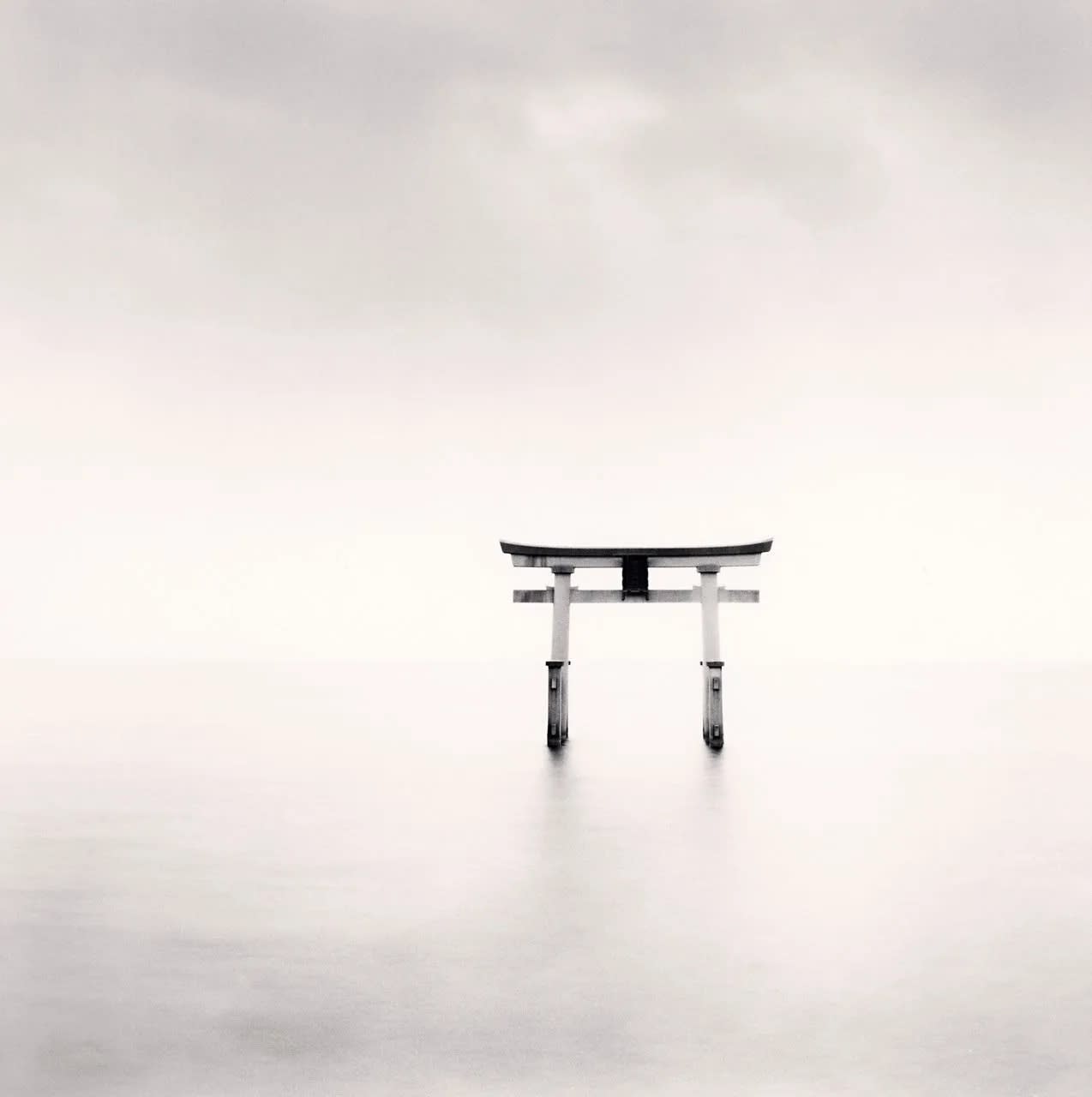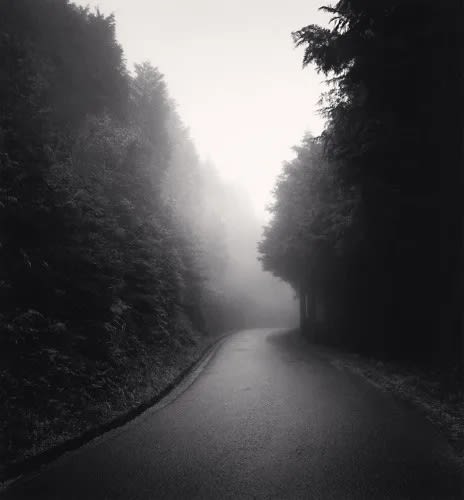-

AN INTRODUCTION FROM MICHAEL KENNA
It seems only yesterday, in the autumn of 1987, when I boarded Pan Am Flight 28 from San Francisco to Tokyo Narita for my first visit to Japan. I had been invited to attend a solo exhibition of my work at Gallery Min in the Tokyo neighborhood of Meguro, and I was both thrilled and nervous. I don’t remember how I found my way to an old and well-worn business hotel close to the gallery, but I do remember, quite vividly, walking along orange sodium lit streets in the middle of a steamy, humid night, dazed yet unable to sleep, courtesy of jet lag.
The shops were closed and mountains of unattended merchandise lay on the pavements, apparently safe from theft. I recalled this experience years later when I inadvertently left my Hasselblad camera, lens, back and meter on a public park bench in Kumamoto, Kyushu, and then drove for many miles to another location, unaware that my equipment was no longer with me. On discovering my loss, hours later, I was a little disappointed that my guide, Satoshi Tanaka, seemed unconcerned. Despite my anxious enquiries of where I could purchase another camera, I was assured that my equipment would be perfectly safe. He was correct, of course, because we were in Japan! After a quick phone call, I was informed that my camera had been handed in to a park attendant and was awaiting pick up.
I write these few words here in Kyoto, while watching the Kamo River flow by. I recall, with some degree of nostalgia, memories from my initial visit to this ancient capital, 36 years ago, when everything was new and exciting to me. I observed, explored and photographed. I remember wandering along the lanes of Gion, shyly entering dark, exotic Buddhist temples and bright, colorful Shinto shrines. I attended ritualistic tea ceremonies, marveled at beautiful scrolls with inscrutable kanji characters. I discovered the mysteries of hot ofuro bathing and slept on tatami floors in an old riverside ryokan. I dined in convenience stores and attempted my first faltering words of Japanese. Falling in love with Japan, then and there, quickly, quietly, and inexorably, was inevitable. Of course, I will always remain a gaijin to the Japanese. I still have, for example, the bad habit of crossing empty road intersections without waiting for a green light, and only foreigners would do such naughty deeds in Japan.
Photography can be, and often is, a solitary pursuit, and with all due respect to my wonderful family, friends and associates, I enjoy time alone, in my darkroom, out walking for hours, photographing in the landscape, and/or while sitting quietly in sacred spaces such a churches, temples, and shrines. At one and the same time, I fully acknowledge that photography can also be a magical and alchemical social-sharing process where the photographer has an opportunity to engage in conversations, silently or otherwise, with whatever subject matter is encountered. In that latter sense, these hundred photographs could be regarded as visual souvenirs of personal connections established, collaborations entered into, and friendships shared. Whereas I agree with my friend Pico Iyer who refers to photographs as prayers, I would even argue that it is not too far-fetched to consider these photographs to be a series of intimate love letters to a treasured beloved. Japan has a long and rich tradition of reciprocal gift giving. I have been the grateful recipient of so much over so many years in Japan, and I know that I will never be able to give back in equal measure. I hope this work can be seen as a small token of my desire to do so. I also hope this work can be viewed as a homage to Japan and that it will serve to symbolize my immense ongoing appreciation and deep gratitude for this beautiful and mysterious country.
Michael Kenna
-

PHOTOGRAPHING JAPAN:
THE WORK OF MICHAEL KENNA
by Kohtaro Iizawa / Photography CriticMichael Kenna first visited Japan in 1987. Perhaps, during this initial short stay in that unknown land, the spirits which dwelt there cast a spell on him, for he went on to visit and photograph in Japan again and again. In 2003, Nazraeli Press, (U.S.A.) and Editions Treville, (Japan) co-published a collection of 95 Kenna photographs in a book titled Japan.
For this publication, I contributed an essay on the “lightness and smallness” of Kenna’s point of view on Japan. I described his photographs as being characterized by a feeling of floating or lightness, with landscapes that are “weightless, as if they are suspended and dancing in mid-air.”
By employing unique compositional arrangements in which “small objects” are positioned as though in a miniature garden, and by including few elements, I suggested that his photographs could be read as, “pictures written in short poem form”, like visual haikus.
Looking at the work in his new book, Japan / A Love Story, perhaps the definitive collection of Kenna’s Japan photographs, I feel that these same components are still there. And yet, on viewing his work afresh, I have realised that although he does indeed incorporate a Japanese, or perhaps “Eastern” sense of beauty and perspective, he does not follow their norms blindly. In short, it appears that he has now fused his own Western aesthetic with a new Eastern sensibility, awakened by his visual experiences in Japan.The words “wabi” and “sabi”, for example, are often used to describe a uniquely Japanese experience of beauty. Wabi comes from the verb “wabu”, meaning to remove oneself from the world and lead a modest life, and describes a mindset of honouring and even finding beauty in that which is plain, imperfect, and humble. In Zen Buddhism and its Influence on Japanese Culture (1938), Daisetz Suzuki, widely known as an exponent of the spirit of Zen, is more direct, defining the true meaning of wabi as “poverty”. Sabi, on the other hand, comes from the verb “sabu”, meaning to age or fade with time, and it implies solitary and lonely characteristics.
The sense, sometimes referred to by combining the two words into “wabi-sabi”, of discovering the ideal of beauty in the imperfect – in that which is usually considered negative – is not often found in Kenna’s work. Granted, the Japanese landscapes that emerge from his photographs are simple, even minimal, but there is nothing of poverty here. Rather, they are rich, joyful, and abundant. They do not contain the atmosphere of a solitary pursuit, but rather they have an approachability that prompts people to look more closely, join hands and respond as one.
Another important aspect of Japanese art proposed by Daisetz Suzuki in Zen Buddhism and its Influence on Japanese Culture is asymmetry. There is indeed a tendency in Japanese painting and architecture to avoid the beauty of balance and symmetry, which is echoed in many of Kenna’s photographs. However, in the same thoughtful and measured way, as seen for example in his photographs of torii shrine gateways and Mount Fuji, Kenna does also embrace symmetrical compositions. When seen in this light, it becomes clear that these Michael Kenna photographs of Japan do not adopt wholesale the traditional Japanese aesthetic. Rather, they have been created through his absorption and adaptation of that aesthetic against a background of his own accumulated visual experience. Despite his deep affinity with the Japanese landscape and culture, he has not compromised his own standards of beauty, which he continues to nurture throughout all of his work. This is doubtless why his photographs strike audiences in both the East and the West as so remarkably fresh and surprising.
-

Sponsored and presented by Nikkei and the Financial Times
Curated by Peter Fetterman, organised and produced by Peter Fetterman Gallery
Exhibition & Tour Director - Kate Stevens
Art Direction:
Tokyo - Office RAM, Gallery Art Unlimited
Los Angeles and London - Ethos Fine Arts
Hong Kong - Design for Culture贊助及呈獻 日本經濟新聞及英國《金融時報》
主辦及製作 Peter Fetterman Gallery 策劃人 Peter Fetterman
展覽總監 Kate Stevens
美術指導:
東京 - Office RAM, Gallery Art Unlimited
洛杉磯及倫敦 -Ethos Fine Arts香港 - Design for Culture
主催 日本経済新聞社、Financial Times企画 Peter Fetterman Gallery
展覧会・ツアーディレクター Kate Stevens
アートディレクション:東京 - RAM, Gallery Art Unlimited
ロサンゼルス、ロンドン - Ethos Fine Arts
香港 - Design for Culture